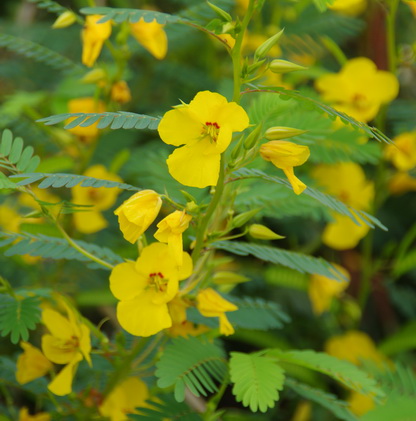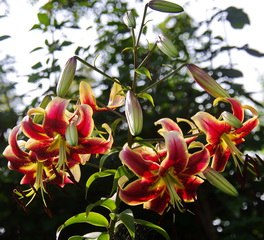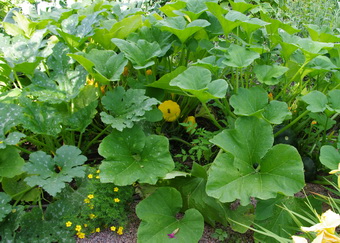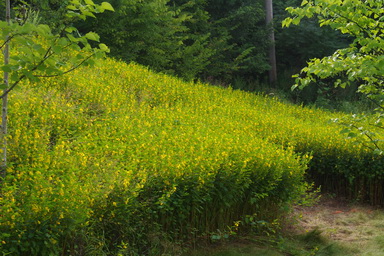| Back to Back Issues Page |
 |
|
Dallying In The Dirt, Issue #183 --- The native Partridge Pea outshone the exotics August 15, 2014 |

The Garden Writers’ symposium in Pittsburgh was a great event but I must admit that I’m always glad to get back home. We saw some wonderful gardens but I realize that I have been doing this too long. I think I have become a bit jaded after seeing so many different gardens over the years and it takes something pretty special to get me to raise my camera. A quick look says that I only managed to take about 250 pictures over the four days of touring. Many of those are just lazy record keeping; take the picture of the plant and then take a picture of the label next to it, that avoids the use of pencil and paper. That’s one of the joys of digital photography, the minuscule cost per picture. I showed you the Tillandsia arches at the Phipps Conservatory last week and there was much more to see there. They have the typical large Palm house that you enter through and then a wide variety of smaller, themed glasshouses. One of their main contributions is their efforts to make
their whole operation energy efficient.
 The Assistant Gardener had done an excellent job of keeping everything alive and she did her best to keep the Tomato and Cucumber harvest under control. Many of the weeds managed to elude her but the garden was still a very welcome sight upon my return. A few very late Lilies were in full bloom and they continue to brighten up the fading garden. The various types of Lilies have been supplying gorgeous blooms and food for the Red Lily Beetle for most of the summer, reinforcing my love affair with then and the justifying the constant battle with the Beetle. The picture is of a fairly new hybrid whose label has gone for a wander. It appears to be an Oriental hybrid of a group know as Black Beauty and this variety may be Scheherazade, at
least that sounds vaguely familiar. Its mid August bloom with large recurved flowers on tall strong stems, certainly make it a stand out in the garden. It has a single stem this year and I’ll eagerly await next year to see if it multiplies. Its late arrival and heavy foliage also make it less likely to be a target of the dastardly Red menace.
The Assistant Gardener had done an excellent job of keeping everything alive and she did her best to keep the Tomato and Cucumber harvest under control. Many of the weeds managed to elude her but the garden was still a very welcome sight upon my return. A few very late Lilies were in full bloom and they continue to brighten up the fading garden. The various types of Lilies have been supplying gorgeous blooms and food for the Red Lily Beetle for most of the summer, reinforcing my love affair with then and the justifying the constant battle with the Beetle. The picture is of a fairly new hybrid whose label has gone for a wander. It appears to be an Oriental hybrid of a group know as Black Beauty and this variety may be Scheherazade, at
least that sounds vaguely familiar. Its mid August bloom with large recurved flowers on tall strong stems, certainly make it a stand out in the garden. It has a single stem this year and I’ll eagerly await next year to see if it multiplies. Its late arrival and heavy foliage also make it less likely to be a target of the dastardly Red menace. One should never leave a summer squash planting for a week. Small plants with many bright yellow blooms turn into giant triffids covering the walkways and holding a wealth of overgrown fruit. Zucchini and her cousins have an amazing growth rate. On Monday they are small, delicate vegetables and by Friday they are baseball bats capable of being made into an infinite quantity of Zucchini bread. I have round Eight Ball types, long, ridged Romanescu types, scalloped Patty Pan types and a couple of colours of ordinary Zucchini, all of which now own the garden and make me question my sanity for having planted so many in the first place. I must get out there and pick all of the overgrown fruit so that they will continue to produce the small succulent new ones that are wonderful for grilling or stir frying. A couple of the large types will make it to the table as stuffed Zucchini but you can’t eat that every night either. Neighbours and friends should keep an eye out for baskets on their doorsteps.
One should never leave a summer squash planting for a week. Small plants with many bright yellow blooms turn into giant triffids covering the walkways and holding a wealth of overgrown fruit. Zucchini and her cousins have an amazing growth rate. On Monday they are small, delicate vegetables and by Friday they are baseball bats capable of being made into an infinite quantity of Zucchini bread. I have round Eight Ball types, long, ridged Romanescu types, scalloped Patty Pan types and a couple of colours of ordinary Zucchini, all of which now own the garden and make me question my sanity for having planted so many in the first place. I must get out there and pick all of the overgrown fruit so that they will continue to produce the small succulent new ones that are wonderful for grilling or stir frying. A couple of the large types will make it to the table as stuffed Zucchini but you can’t eat that every night either. Neighbours and friends should keep an eye out for baskets on their doorsteps.Now it’s time to answer a few of my reader’s questions. Don’t forget to check the front page of the Website for frequent short ideas for current gardening activities. Richard Asks? A short question this afternoon. As I was walking around my Rose of Sharon and my small climbing rose bush, I noticed a brown/green type beetle (some on top of each other!) in the flower eating the petals!!! What to do???? Mary Asks? what's with all the basil (thai and sweet) turning black, brown this year?? I've planted three batches of thai basil - two
pots of the third batch are gone again - the third pot (planted with other herbs) seems ok - for the moment...any ideas? too hot? too wet?? some kind of fungus this year for the basil?? |
| Back to Back Issues Page |
 That’s difficult with a greenhouse but they try. Deep holes in the ground are a source of cool air that they pump through their main glasshouses in the summer and that is quite effective and much cheaper then trying to use conventional cooling systems. They recycle most of the rain water that falls on their buildings and their newest building even has a waste water recycling system through a series of created wetlands. The plant that attracted most attention from our group was outside covering some steep slopes with a mass of bright yellow flowers and some very delicate foliage. Eventually we found one of our group that identified it as
That’s difficult with a greenhouse but they try. Deep holes in the ground are a source of cool air that they pump through their main glasshouses in the summer and that is quite effective and much cheaper then trying to use conventional cooling systems. They recycle most of the rain water that falls on their buildings and their newest building even has a waste water recycling system through a series of created wetlands. The plant that attracted most attention from our group was outside covering some steep slopes with a mass of bright yellow flowers and some very delicate foliage. Eventually we found one of our group that identified it as